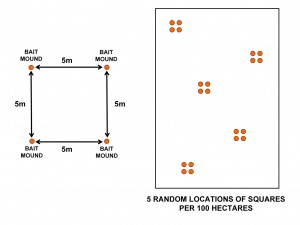Soil-dwelling insect pests can seriously reduce plant establishment and populations, and subsequent yield potential.
Soil insects include:
- cockroaches
- crickets (view life cycle)
- earwigs (view life cycle)
- black scarab beetles (view life cycle)
- cutworms (view life cycle)
- false wireworms (view life cycle)
- true wireworms
- cockchafers (view life cycle diagrams of redheaded, blackheaded, and yellowheaded cockchafers)
Farm management, and specifically cultivation practices, can directly influence the type and number of soil insects in your fields.
- Weedy fallows and volunteer crops provide habitat for soil insects, and encourage their build-up.
- Insect numbers decline during a clean long fallow because of a lack of food.
- Summer cereals followed by volunteer winter crops promote the build-up of earwigs and crickets.
- High stubble levels on the soil surface can promote some soil insects that use decomposing stubble as a food source and shelter. However, retaining stubble can also mean that pests continue feeding on the stubble instead of germinating crops.
- Zero tillage encourages beneficial predatory insects and earthworms.
- Incorporating stubble promotes black field earwig populations.
- False wireworms are found under all intensities of cultivation but decline if stubble levels are very low.
Soil insect control measures are normally applied prior to, or at, sowing. Since different insects require different control measures, the species of soil insects posing a threat to the crop must be identified before planting.
Monitoring and sampling for soil insects
Soil sampling by spade
- Take a number of spade samples from random locations across the field.
- Check that all spade samples are deep enough to take in the moist soil layer (this is essential as many soil insects inhabit the interface between the moist and dry soil).
- Hand sort samples to determine type and number of soil insects.
Spade sampling is laborious, time consuming and difficult in heavy clay or wet soils.
Germinating seed baits
For southern and western regions (canola)
Grain baits can be used to detect the presence of false wireworm (FWW) prior to sowing, but grain baits cannot be used to estimate numbers. Direct soil sampling is needed to make an estimate of the number of FWW per m2.
- Oat or canola grain (200-300g) pre-soaked for 24 hours, buried in 5-10 random sites in shallow holes (50 mm deep) and covered with 10 mm of soil.
- After 7 days, the soil around the baits should be removed and carefully sorted to check for FWW
For the northern region (sorghum, maize, sunflower)
Immediately following planting rain:
- Soak insecticide-free crop seed in water for at least two hours (preferably overnight) to initiate germination.
- Use the type of seed to be sown to indicate the species of pests which could damage that crop. e.g. if planting sorghum, use sorghum seed for the baits.
- Bury a dessert spoon full of the seed under 1 cm of soil at each corner of a 5×5 m square at five widely spaced sites per 100 ha.
- For best results – place baits at the interface of the moist subsurface soil. This may mean placing the baits deeper if it is dry. If soil is extremely dry, water the baits once placed in the soil to ensure germination. The insects are attracted to the germinating seed, not the seed itself.
- Mark the position of the seed baits as high populations of soil insects can completely destroy the baits.
- Five days after placing the baits, dig up the germinating seed and count the insects.
Further information
How to recognise and monitor soil insects (DAF Queensland)

